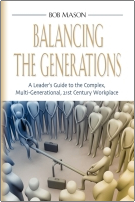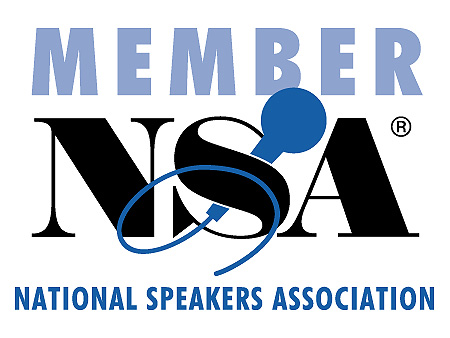For Immediate Release
Review copies and author interview available on request.
Contact: Bob Mason 505-453-5266.
There’s Conflict in the Workplace and Many Leaders Don’t Know What to do About it!
The vast difference in the generations in the workplace is one of the most challenging aspects faced by today’s leaders. For many years the workplace was simple with one generation in charge and another working their way up. The new generation learned from the established generation and waited for their opportunity to make changes. In the 21st Century, it seems newer generations are not waiting to make changes and established generations seem more willing to let them have their way. All this has created a conflict for which leaders and managers are not well equipped. But, help is available!
Bob Mason’s latest book, “Balancing the Generations: A Leader’s Guide to the Complex, Multi-Generational, 21st Century Workplace” is a treasure trove for leaders and managers to learn how to lead in today’s world.
Each generational category has become defined in certain ways and we expect their members to act in a particular manner. It’s a convenient way to order the workplace, but it’s also very inaccurate as people are more than just their birth date. They each have different backgrounds, distinct experiences, and unique hopes and dreams for the future. Also, the truth about the various generations can be surprising. For instance:
1. The GI Generation, born between 1900 and 1927 is the only generation to have a completely common experience: the Great Depression. No other generation has lived through an event that affected every member. That single event not only shaped that generation but greatly impacted the ones to follow.
2. The counter culture period is often credited to the Baby Boom Generation, and they were a very big part. But most, if not all the leaders of that movement were actually from the Silent Generation.
3. Generation X is caught in the middle between two very large generations, but they aren’t nearly as anti-social as they are often portrayed.
4. The Millennial Generation has a cultural diversity, and therefore a considerably varied outlook, that has never been seen before.
One of the difficulties with much of the literature available today is that it tends to be written by a certain generation for that generation and often lacks objectivity. For instance, the perception that Xers don’t work well with others is often expressed by Xers themselves! “Balancing the Generations” avoids that problem and takes a fresh look at the current generational phenomenon. The book is in two parts with the first being a detailed examination of each of five generations that impact the workforce, with an analysis of events that shaped the generations and how each is different yet often very similar. Along the way, the author dispels myths that have grown up around each generation.
The second part of the book is a guide for leaders to help them bring the various generations together and avoid the conflict that’s becoming more common. Understanding critical points about the generations can make leaders more effective. For example:
1. Millennials communicate differently than Boomers. Boomers are often told they must understand that, but Millennials need to grasp the fact as well.
2. Xers grew up in a world they saw as troubled and tend to be very suspicious of change initiated by Boomers. On the other hand, Xers are in a perfect position to bridge the gap between Boomers and Millennials.
3. Changes in technology are not unique to the Millennial Generation. In fact, The GI Generation has probably seen more technological advance than any other. But, the effects of technology on the workplace are another matter and can be overwhelming to older workers.
Above all else, any attempt to diffuse the conflict of the generations must go beyond what generation an individual is associated with and understand the person themselves.
The different generations have become a factor in today’s workplace like never before. Understanding them, and more importantly the individual people in them, will help diffuse conflict and make for a more harmonious and effective work environment.
Bob Mason answers a few questions about the multiple generations in the workplace.
1. Why did you write this book?
I’ve seen so much misinformation about the different generations and seen so many leaders who aren’t prepared to deal with the issue. But it doesn’t have to be a big problem for leaders if they just understand a little about the generations and more importantly, understand the individuals in those generations.
2. Are the generations really that different?
Yes and no. The GI Generation is very different from Generation X. In many ways Generation X is somewhat like the Baby Boomers. The Baby Boomers are becoming more like the GI Generation as they age. There are similarities across all generations, yet differences as well.
3. In “Balancing the Generations” you separate the GI Generation, which many writers do not. In fact you make a big distinction. Why?
Many contemporary authors lump the later GI Generation in with the Silent Generation and call it the Traditionalists. This ignores the fact that there are some very different experiences between these two generations.
4. What are some of the surprises you found in your research?
Just to name a couple, many people think of the counter-culture period of the late 1960s and early 1970s as strictly a Baby Boomer phenomenon but in fact, most of the leaders of that movement were from the Silent Generation. Generation X has some very different views of a period that Boomers saw as very prosperous.
5. What are some of the differences in communicating with various generations?
Everyone assumes that Millennials can’t communicate in complete sentences. That issue is not unique to that generation though. As groups, no generation enters the workplace with an ability to communicate by the standards of that industry or profession. Millennials are no different, but they have demonstrated a great capacity to learn and adapt.
6. There seems to be a lot of turmoil these days about the different generations. Can they really work together in the workplace?
Absolutely! When leaders learn about the individual, wonderful things can happen.
7. What’s the effect of technology on the whole generational issue?
We sometimes forget that our grandparents in the GI Generation went from the Model A to man on the moon and computers. The march of technology is not a new phenomenon. However, that march has become more of an all-out run. That’s what makes technology such an issue. Millennials seem to be better at keeping up, but I predict by the time they’re in their twilight years, they too will be shaking their heads, struggling to keep up.
8. Are there specific factors about the generations that would help managers retain good employees?
This is a big issue in the workplace today. It isn’t complicated though. Leaders need to remember two basic concepts. First people like to feel they are an important part of something. Second, Millennials, and to a lesser extent Xers, want to have opportunities to grow. Staying in the same cubical doing the same thing for 20, 30, or 40 years doesn’t appeal to them.
9. There is considerable concern about the retirement of the Baby Boomers. Who’s going to take their place in management and leadership?
This has become something of a self-fulfilling prophesy in some parts of the business world where, for some reason, it has been decreed that Xers just aren’t ready for leadership roles. In fact leadership ability and generational categorization are not related. Xers actually occupy a somewhat unique position between Boomers and Millennials that smart leaders will capitalize on.
10. In the book you mention immigration. Why is this important when studying the different generations?
Immigration did not use to be a big issue when looking at generations. Immigrants tended to either stay in their own communities or quickly assimilate into the existing society. That isn’t as true now and so the workplace may see multiple cultures openly present.
11. You talk about the need for all generations to be open-minded and adapt. Hasn’t that always been the case?
Open mindedness has not been a particularly noticeable hallmark of the business world in the past. Especially with the diversity of the Millennial Generation, we can no longer ignore the effect of that diversity. Successful leaders are the ones who strive to understand individuals as well as their generation and who are open to input from anywhere.

Bob Mason is a speaker, trainer, and author and retired U.S. Air Force officer. After 30 years of leadership experience he founded RLM Planning and Leadership to transform leadership by developing great leaders. Bob works with organizations that want to excel by training managers to lead and creating great strategic plans to keep leaders focused.
For more information visit http://www.planleadexcel.com.



